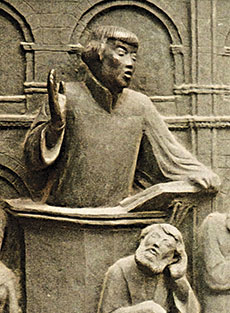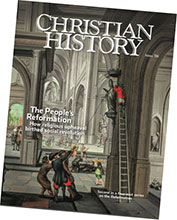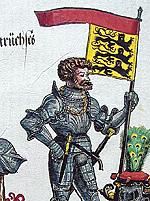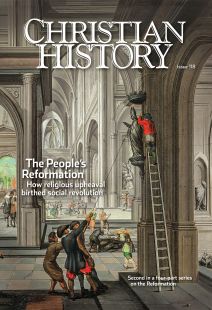When the state advanced the church

ON THURSDAY, MARCH 9, 1522, the pastor of Zurich’s Grossmünster Church, Huldrych Zwingli (1484–1531), and some of his friends distributed two smoked sausages at the house of printer Christoph Froschauer. This was scandalous: this Thursday happened to be in Lent and was marked for fasting. Criticized, Zwingli argued that fasting should never be mandatory and even preached a sermon about sausages called “Regarding the Choice and Freedom of Foods.”
The story became legendary, and the conflict it provoked was sharp. In the tale of Zwingli and his city—and the other cities where the Reformation took hold—we see how the personal and social, the religious and political, intermingled in those chaotic decades as the Reformation lurched forward.
We built this city on the Reformation
The German-speaking lands in which the Reformation first arose were home to two primary kinds of political organizations: regional territories ruled by princes and “free imperial” city-states ruled by councils and recognizing no authority other than the theoretical authority of the distant emperor. (Both princes and members of city governments were typically referred to as “magistrates.”) There were, of course, important cities within the princely territories, and independent city-states often ruled a considerable swath of surrounding territory. This was especially the case in Switzerland, divided into autonomous republics called “cantons,” some of which were quite rural.
But the Reformation spread most rapidly through the cities with their wealthy merchants and urban aristocrats, particularly after the crushing of the Peasants’ War and the firm identification of the mainstream Reformation with the authority of princes and city magistrates (see “They wanted God to save his own,” pp. 19–21).
And in the early years of the Reformation, the most dramatic growth occurred in areas outside “princely” control: the free imperial cities and the Swiss cantons. There the Reformation was driven largely by popular demand for a simpler faith focused on scriptural preaching and moral reform—the “pure Gospel.”
There were considerable connections between these popular movements within the cities and rural peasant uprisings which also claimed the banner of the “pure Gospel.” But whereas those uprisings were disastrous failures, the urban movements were in many cases successful. The “Urban Reformation” was not a violent revolution or a top-down imposition—it was a complex process largely driven from below, but for which the consent of the magistrates was crucial.
This Reformation in the cities built on reform efforts already going on throughout the later Middle Ages. Many cities saw a great demand for preaching, and some clergy held positions devoted purely to preaching (Zwingli was just such a Leutpriester, or “people’s priest,” in Zurich), alongside more conventional clergy whose duties focused primarily on celebrating the Mass.
Order Christian History #118: The People’s Reformation in print.
Subscribe now to get future print issues in your mailbox (donation requested but not required).
City governments had also striven for years to force clergy to accept citizenship with its rights and responsibilities; the church argued against this because it feared it would bring clergy under the control of city governments. The fact that some of the most influential people in a city, controlling large amounts of wealth and property, were essentially resident aliens with extraterritorial rights rankled most governments.
When the fugitive Martin Bucer (1481–1551) wrote to the city government of Strasbourg in 1523 offering to become a citizen—because, he said, Scripture taught him he should be a loyal citizen of his community—he was offering it victory in a long struggle between civil and religious authorities. (Two decades later, the older Bucer would take a more independent stance, criticizing authorities’ political and military compromises and demanding that pastors have the authority to excommunicate flagrant sinners.)
The great monastery
The medieval city saw itself as a sacred community, a Christian commonwealth whose members were obligated to love and care for one another by virtue of their baptism. Great humanist reformer Erasmus of Rotterdam argued that cities should be holy communities that fostered the sanctification of their members: “What is a city,” he asked rhetorically, “but a great monastery?”
The Urban Reformation offered a chance to make that vision a reality; hence the great concern with moral reform—ending prostitution, encouraging an earlier age for marriage to prevent fornication, caring for the poor, and regulating conspicuous consumption (see below).
Perhaps no city typifies that urge for reformation more than Zurich. Zwingli went to Zurich in 1518 from pastorates in Glarus and Einsiedeln and began to spread Reformation ideas. He preached through the Gospel of Matthew and attacked church corruption and specific points of church doctrine and practice such as the veneration of saints and the use of images in churches.
While many welcomed his preaching, conflict also arose, especially after the sausage incident. The city council considered the matter and ruled in support of Zwingli. Over the next several years, Zurich’s worshipers saw traditional festivals and processions laid aside.
Zwingli designed a Communion liturgy in the German language which was celebrated for the first time on Maundy Thursday in 1525. Participants sat around tables; wooden bowls and plates were used for the sacrament; there was no organ music or singing; and the sermon took a central place. Zwingli believed that the bread and wine of Communion were figures or representations of Christ’s body and that receiving them helped transform the church into the body of Christ in the world.
Zwingli also saw himself and other ministers of the Gospel as analogous to the Old Testament prophets, since the key function of a prophet is to proclaim God’s Word. When Zurich clergy held intense Bible study sessions culminating in messages for the common people, their Bible study was referred to as “prophesying.” Zwingli saw his job as telling the city magistrates what God’s Word required of them, without wielding political power in his own right.
Partially for this reason, the reforms in Zurich were not fast enough for some of Zwingli’s more radical followers, who saw no reason to “wait” for the city council to act or indeed to give the council any authority in deciding how and when to implement religious reforms.
These “Anabaptists” baptized as adults (rebaptized, their opponents argued) those baptized in infancy. They fought Zwingli tooth and nail to persuade him to abandon his attachment to the city council and its authority. They firmly believed that the power of God and the Spirit of God would work only through believers and not through officials (see “A fire that spread,” pp. 28–32).
Against those infiltrating preachers
Zwingli countered in his Commentary on True and False Religion that God indeed uses public officials to ensure that his will is carried out. He remarked, “We read in Rom. 16:23: ‘Erastus the treasurer of the city saluteth you.’ If a man is treasurer, is he not a person in authority . . . not even a treasurer, be he a person in authority or not, can administer this office without there being a person in authority who has made him treasurer.” Zwingli won the argument, and the Anabaptists were expelled from the city. Worse, some were executed by drowning.
The modern notion called the “separation of church and state” simply did not exist in the sixteenth century, and, where it did arise (as among the Anabaptists), it was quickly crushed. Zwingli, Luther, Calvin, and their friends and allies were all referred to as “magisterial reformers” because they depended upon the magistrates to enforce their religious reforms. They believed that God authorized the magistrate to maintain justice and punish the wicked, which included oversight of external matters pertaining to the church.
Luther wrote in his little treatise titled Infiltrating and Clandestine Preachers, addressed to government officials:
I have learned, my dear lord and friend, how the Anabaptists are seeking to infiltrate also in your vicinity and to infect our people with their poison. … You have discharged your office in a proper and praiseworthy manner against these emissaries of the devil. … [I] also ask and advise all other magistrates, cities, and princes to be on the alert against these infiltrators, so that we do our duty.
And Zwingli argued in his Commentary on True and False Religion that he had observed “the saintliness and faith of large numbers of believers who have yet so administered magisterial offices as to glorify God by general peace and righteousness,” as well as the “viciousness of bad men who pretend to be Christians but are not truly such,” and that he believed “that no man is even capable of administering a magistracy properly unless he is a Christian.”
He added, “How, pray, does the state differ from the church? I mean in regard to the external habits and associations of life; for as far as the heart is concerned, I am well aware that the only church of Christ is that which trusts in Christ.”
Zwingli rejected the sharp distinction Luther made between law and Gospel: all of Scripture is divine law and is binding on believers. This is why he had no tolerance for images in worship: they contradict God’s law and thus leave no room for pragmatism or compromise.
On his side Luther saw Zwingli as a fanatic with dangerous sacramental and political views (see “Allies or enemies?,” pp. 15–17). Though Zwingli’s version of social change was more conservative than the Anabaptists or the peasant rebels, Luther still thought it an inappropriate mingling of law and Gospel that called on Christians to use coercive force as Christians rather than simply as obedient subjects (or charitable wielders) of worldly authority.
In the end Zwingli followed his conscience and became a chaplain to the troops of Zurich, losing his life at the hands of his Catholic foes. Luther quipped, “Those who live by the sword, die by the sword.”
For Luther violence on behalf of the state, maintaining order and crushing rebellion, was legitimate and authorized by God. But attempts to change society by force in the name of the Gospel were blasphemous and under God’s curse.
No laughing, swearing, or playing dice
In Zurich under Zwingli and the strict hand of his successor, Bullinger, rules for public behavior were tightened up and church attendance became mandatory. In 1525 the Zurich council instituted a marriage court that could rule on issues of marriage, divorce, and related moral (or immoral) behavior. The Zurich Church Ordinances of 1520–1675 contain 400 specific bits of legislation passed by the Zurich City Council over a century and a half beginning in Zwingli’s day. Every aspect of life was regulated with the aim of producing citizens who were not only Christian in name but in deed and lifestyle.
These regulations prohibited swearing and playing cards and dice, condemned being absent from church without a proper reason, regulated what kind of clothes should be worn, required the baptism of newborn children (the rule that the Anabaptists ran afoul of), controlled the sorts of gravestones that could be erected in the cemetery, regulated begging and beggars, controlled what kind of weapons people could carry, and finally specified whether one was allowed to laugh during the sermon (one was not).
While Zwingli oversaw the reform of Zurich, the steady hand of Johannes Oecolampadius (1482–1531) guided reform in Basel. Born in Germany but now residing in Switzerland (see “A motley, fiery crew,” pp. 43–48), Oecolampadius became cathedral preacher in Basel in 1515. He also served as an assistant and Hebrew consultant to Erasmus as the latter translated his Greek New Testament. Among his youthful actions in Basel, he preached a sermon in 1518 against the custom of telling humorous stories in Easter sermons!
After a brief and unsuccessful stint as a monk, Oecolampadius went back to Basel in 1522 as both priest at St. Martin’s Church and professor at the University of Basel. There his lectures on Isaiah argued for reform.
He prevailed with the city council in 1523 and 1524 in a series of public disputations, though the news of the Peasants’ War and the council’s general fear of the radical pace of the Anabaptists made it slow to act. But in 1528 Oecolampadius, Zwingli, Bucer, and other reformers participated in a disputation at Bern which led that city to adopt the Reformed faith in the form of 10 theses, including these:
The Church of Christ makes no laws and commandments without the Word of God. Hence human traditions are no more binding on us than as far as they are founded in the Word of God. … The mass as now in use … is contrary to the Scripture, a blasphemy against the most holy sacrifice, passion, and death of Christ, and on account of its abuses an abomination before God. The worship of images is contrary to Scripture. Therefore images should be abolished when they are set up as objects of adoration.
New day, new liturgy
The example of Bern took root in Basel. The council in 1529 abolished the Mass, issued an order of liturgy and church discipline, and elected Oecolampadius head of the church in Basel. The new liturgy was moderate, retaining morning and evening prayer and the observance of some church festivals, including those honoring Mary and some saints. It showed Oecolampadius’s willingness to retain those aspects of Catholic practice most acceptable to the people and least offensive to Reformed theology; he understood that some things are worth fighting for and some things are not.
While the city suffered some upheaval as reform took root, in the end the populace was agreeable. In 1534 under Oecolampadius’s successor, they adopted a confession similar to the one developed at Bern; it was read every Maundy Thursday, and subscription was required to it at ordination services until the late nineteenth century!
Strasbourg too fared well thanks to the conciliatory spirit of Martin Bucer (1491–1551), who repeatedly put forth stalwart, though unfortunately failed, attempts to bring differing reformers to unity (see “A motley, fiery crew,” pp. 43–48).
Bucer arrived in Strasbourg in 1523 already convinced of the truth of the Reformation, released from his monastic vows, excommunicated, and married to a former nun. He was protected by reformer Matthew Zell (1477–1548) and his wife Katharina Schütz Zell (c. 1497–1562). Matthew Zell had influence with the city council and took Bucer as his unofficial chaplain. Bucer became a citizen of the city and pastor of St. Aurelia’s Church.
Unrest erupted in 1524 when Conrad Treger, a local Augustinian prior, called Bucer, Zell, and others heretics; Protestant rioters broke into monasteries and destroyed images. The council supported Bucer and arrested Treger, who eventually left the city; reforms in worship followed, based in part on Bucer’s writings in his book Basis and Cause that attacked vestments, altars, and Roman ritual.
At first the city council allowed Bucer’s reforms into the parish churches while continuing Masses at the city’s cathedral and college churches. But in 1529 the council suspended the Mass altogether and replaced it with two Sunday preaching services in every church in town. It followed this up with a 1530 decree directing that images and side altars should be removed from churches.
Bucer introduced “special wardens” into each congregation to supervise what people did as well as what they believed. Concerned by an influx of refugees, many of whom were Anabaptists, he and his wardens soon asked the city council to take complete control of the church. The council delayed, but the events of the Münster Rebellion, when radical Anabaptists seized power in the town of Münster (see “A fire that spread,” pp. 28-32), finally pushed it to act out of fear of similar events occurring in Strasbourg.
Bishop bucer
In 1534 the council accepted articles on church doctrine and a confession drawn up by Bucer as the official standards of worship and doctrine in Strasbourg. Anabaptists had to subscribe or leave. Many people recognized Bucer’s authoritative status; in a letter to a friend in 1535, reformer Wolfgang Capito (1478–1541) wrote against the possibility of Bucer leaving for another post: “Bucer is the bishop of our church, a status which we should not rashly change.” (Little did Capito know that Bucer would one day also marry his widow, Wibrandis Rosenblatt, who had already been married to Oecolampadius as well; see “Bride of the Reformation,” p. 49).
In the magisterial Reformation, good order was the goal, because without good order, without moral rectitude, the Gospel would fall on weed-choked ground, and that the reformers could not endure—not in any of their cities. But Bucer and other urban reformers eventually became disillusioned with the failure of their communities to be the holy commonwealths that they envisioned.
In October 1531 five Catholic Swiss cantons, upset by a Protestant food blockade, declared war on Zurich. Zwingli joined the battle as chaplain to the troops, supposedly bidding farewell to his wife with the statement “The hour is come that separates us. Let it be so. The Lord wills.” She responded, “We shall see each other again if the Lord will. His will be done. And what will you bring back when you come?” He replied, “Blessing after dark night.”
But the troops from Zurich were overwhelmed and underprepared; in the ensuing battle, 500 out of 3,500 men, including Zwingli, died at the hands of a nearly 7,000-member Catholic army. Oecolampadius died later that same year, though not in battle. Bucer escaped an early death, but fled the power of Emperor Charles V and took refuge in England, where he once again began to imagine what the “kingdom of Christ” would look like, this time on a larger scale.
The fullest embodiment of the goals of the urban reformers would be Calvin’s Geneva, which, in turn, spread its version of the holy community around Europe and to the New World. When John Winthrop proclaimed to the first settlers in Massachusetts that they would be a “city on a hill,” he was not just quoting a biblical passage. He was invoking hopes and dreams that went back to the earliest years of the Reformation and beyond them to Erasmus’s hope for a city that would be “nothing other than a great monastery.” CH
This article is from Christian History magazine #118 The People’s Reformation. Read it in context here!
Christian History’s 2015–2017 four-part Reformation series is available as a four-pack. This set includes issue #115 Luther Leads the Way; issue #118 The People’s Reformation; issue #120 Calvin, Councils, and Confessions; and issue#122 The Catholic Reformation. Get your set today. These also make good gifts.
By Jim West and Edwin Woodruff Tait
[Christian History originally published this article in Christian History Issue #118 in 2016]
Jim West is professor of biblical studies at Quartz Hill School of Theology and lecturer in biblical and Reformation studies at Ming Hua Theological College. He blogs about Zwingli and the Reformation frequently at Zwinglius Redivivius. Edwin Woodruff Tait is consulting editor at Christian History.Next articles
Allies or Enemies?
The Reformers soon divided over crucial issues; Luther himself was one reason why
Robert D. LinderNot only what was believed but what was done
Reformers wanted to change behavior, not just doctrine
Jon BalserakThey wanted God to save his own
Had Luther argued only for spiritual changes? German peasants didn’t think so
Edwin Woodruff TaitSupport us
Christian History Institute (CHI) is a non-profit Pennsylvania corporation founded in 1982. Your donations support the continuation of this ministry
Donate






